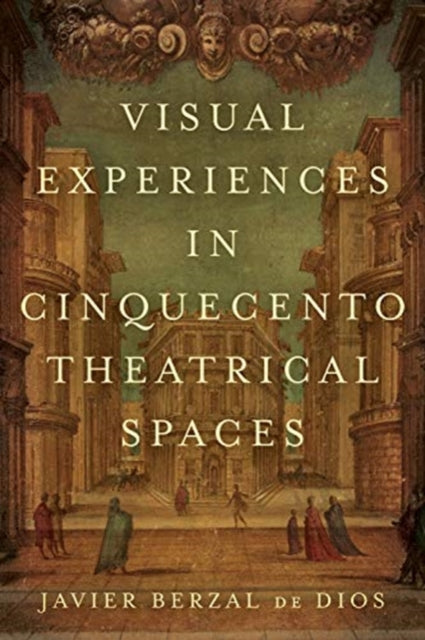Jimena Berzal de Dios
Visual Experiences in Cinquecento Theatrical Spaces
Visual Experiences in Cinquecento Theatrical Spaces
YOU SAVE £4.94
- Condition: Brand new
- UK Delivery times: Usually arrives within 2 - 3 working days
- UK Shipping: Fee starts at £2.39. Subject to product weight & dimension
Bulk ordering. Want 15 or more copies? Get a personalised quote and bigger discounts. Learn more about bulk orders.
Couldn't load pickup availability
- More about Visual Experiences in Cinquecento Theatrical Spaces
Visual Experiences in Cinquecento Theatrical Spaces explores the complexities of audience experience in sixteenth-century theatre by examining philosophical and aesthetic ideas about space, place, and setting. It argues that artists in this period sought to offer up a complex multimedia experience that would captivate a diverse assembly of theatre-goers rather than cater to a single privileged viewer.
Format: Hardback
Length: 216 pages
Publication date: 22 January 2019
Publisher: University of Toronto Press
Visual Experiences in Cinquecento Theatrical Spaces is a groundbreaking interdisciplinary study that delves into the performative aspects of early modern theatre, with a particular focus on the often overlooked complexities of audience experience. By examining the philosophical and aesthetic ideas about space, place, and setting during the sixteenth century, the book reveals how artists consciously departed from traditional representations of real spaces on stage, opting instead for more imaginative and collaborative engagements that were free from strict definitions of naturalism. This innovative approach breaks with traditional interpretations of early modern staging techniques, arguing that the primary goal of artists in this period was not to cater to a single privileged viewer through the creation of a naturalistically unified stage but rather to offer up a complex multimedia experience that would captivate a diverse assembly of theatre-goers.
The book explores the various theatrical spaces of the sixteenth century, including indoor theatres, outdoor spaces, and public squares, and examines how these spaces were designed and utilized to enhance the audience's experience. It discusses the use of lighting, sound, and stage design to create immersive environments that transported the audience to different worlds and times. The book also examines the role of the audience in shaping the performance, highlighting the ways in which spectators interacted with the actors, responded to the drama, and contributed to the overall experience of the theatre.
One of the key themes of the book is the idea of "spectacle" and how it shaped the early modern theatre. The authors argue that spectacle was not just a visual or auditory experience but a multi-sensory one that involved the entire body and mind of the audience. Spectacle was used to create a sense of awe, wonder, and excitement, and to draw the audience into the world of the play. However, the authors also note that spectacle was often used to manipulate and control the audience, and to reinforce social and political hierarchies.
Another important theme of the book is the idea of "place" and how it was used to create meaning and identity in the theatre. The authors argue that place was not just a physical location but a symbolic one that carried cultural, social, and political significance. The theatre was used to represent and explore the relationships between different places, and to explore the ways in which these relationships shaped the lives of the characters and the audience.
The book also explores the role of the audience in shaping the performance, highlighting the ways in which spectators interacted with the actors, responded to the drama, and contributed to the overall experience of the theatre. The authors argue that the audience was not just a passive recipient of the performance but an active participant who contributed to the creation of the spectacle. Spectators were encouraged to engage with the play in a variety of ways, including through applause, laughter, and even physical interaction with the actors.
In conclusion, Visual Experiences in Cinquecento Theatrical Spaces is a groundbreaking and essential study that offers a fresh perspective on the performative aspects of early modern theatre. Through an interdisciplinary approach, the book explores the complex relationships between space, place, and audience experience, and sheds light on the ways in which these relationships shaped the theatre of the sixteenth century. The book is a valuable resource for scholars and students of theatre, history, and cultural studies, and will continue to inspire and influence future research and performance.
Weight: 500g
Dimension: 163 x 238 x 19 (mm)
ISBN-13: 9781487503888
This item can be found in:
UK and International shipping information
UK and International shipping information
UK Delivery and returns information:
- Delivery within 2 - 3 days when ordering in the UK.
- Shipping fee for UK customers from £2.39. Fully tracked shipping service available.
- Returns policy: Return within 30 days of receipt for full refund.
International deliveries:
Shulph Ink now ships to Australia, Belgium, Canada, France, Germany, Ireland, Italy, India, Luxembourg Saudi Arabia, Singapore, Spain, Netherlands, New Zealand, United Arab Emirates, United States of America.
- Delivery times: within 5 - 10 days for international orders.
- Shipping fee: charges vary for overseas orders. Only tracked services are available for most international orders. Some countries have untracked shipping options.
- Customs charges: If ordering to addresses outside the United Kingdom, you may or may not incur additional customs and duties fees during local delivery.


